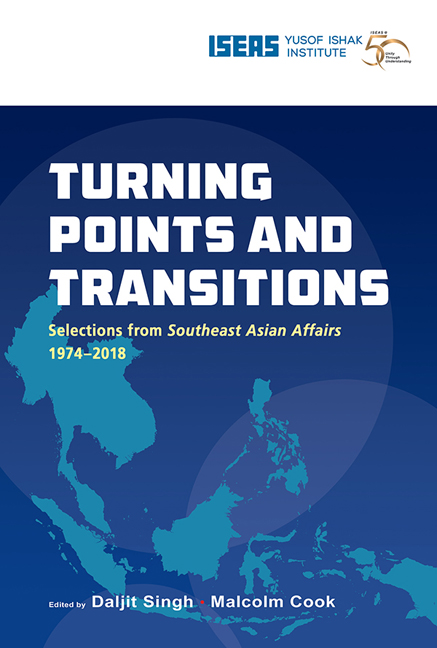Book contents
- Frontmatter
- Contents
- Message from the Director
- Foreword
- Foreword
- Introduction
- THE REGION
- BRUNEI
- CAMBODIA
- INDONESIA
- LAOS
- MALAYSIA
- The Security “Gap” in Peninsula Malaysia (1976)
- The ‘Battle Royal’ – The UMNO Elections of 1987 (1988)
- Malaysia: A Fateful September (1999)
- Tears and Fears: Tun Mahathir's Last Hurrah (2004)
- Malaysia: Political Transformation and Intrigue in an Election Year (2009)
- MYANMAR
- THE PHILIPPINES
- SINGAPORE
- THAILAND
- VIETNAM
Malaysia: A Fateful September (1999)
from MALAYSIA
Published online by Cambridge University Press: 29 May 2019
- Frontmatter
- Contents
- Message from the Director
- Foreword
- Foreword
- Introduction
- THE REGION
- BRUNEI
- CAMBODIA
- INDONESIA
- LAOS
- MALAYSIA
- The Security “Gap” in Peninsula Malaysia (1976)
- The ‘Battle Royal’ – The UMNO Elections of 1987 (1988)
- Malaysia: A Fateful September (1999)
- Tears and Fears: Tun Mahathir's Last Hurrah (2004)
- Malaysia: Political Transformation and Intrigue in an Election Year (2009)
- MYANMAR
- THE PHILIPPINES
- SINGAPORE
- THAILAND
- VIETNAM
Summary
In December 1974 thousands of demonstrators in Kuala Lumpur were dispersed by baton-wielding police, aided by tear gas. Hundreds were arrested. Among those detained under the Internal Security Act (ISA) was youth leader Anwar Ibrahim, probably at the behest of Education Minister Dr Mahathir Mohamad. In September 1998 the two key actors held different positions, but the scenes played out were much the same.
September began with the unexpected imposition of currency controls on day one. More dramatically, on day two Prime Minister Mahathir sacked Anwar from the Deputy Prime Minister and Finance portfolios. In the early hours of day four Anwar was stripped of both the deputy leadership and even membership in the United Malays National Organisation (UMNO), the dominant party in the ruling coalition. On 20 September balaclava-clad, M16-wielding police Special Forces broke down an open door and arrested Anwar, who was then held under the ISA for allegedly endangering public security. At the end of the month he was arraigned before the court, charged with five counts of corruption (abuse of power) and five of sodomy.
The drama of September brought Malaysia unsought international prominence, and opened up many questions. What went wrong between the Prime Minister and his designated heir? Did the fall-out from these events threaten Dr Mahathir's long rule? How strong was the movement for reformasi? Could Anwar make a comeback? Was this yet another power struggle between UMNO factions, or did it represent something more profound?
What Went Wrong?
Relations between Mahathir and Anwar have long been complicated. They first came in contact in 1969, when both were in opposition to Prime Minister Tunku Abdul Rahman. Mahathir spoke at student meetings organized by Anwar, and a student journal under Anwar published a chapter from Mahathir's Malay Dilemma, after the book had been banned. Their paths diverged in the 1970s as Mahathir returned to the UMNO fold and Anwar strengthened his position as a youth leader, particularly with the Malaysian Islamic Youth Movement (known by its Malay acronym, ABIM). In 1982 Mahathir persuaded Anwar to join UMNO, and the two of them worked closely together until Anwar became deputy party and government leader in 1993. From that time the relationship was strained, and both local pundits and the international media frequently predicted a split.
- Type
- Chapter
- Information
- Turning Points and TransitionsSelections from Southeast Asian Affairs 1974-2018, pp. 431 - 443Publisher: ISEAS–Yusof Ishak InstitutePrint publication year: 2018

